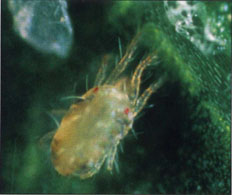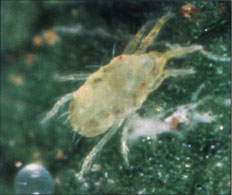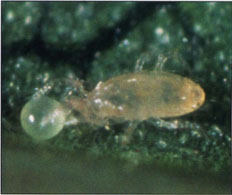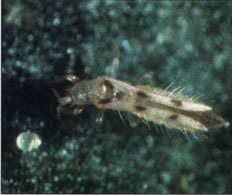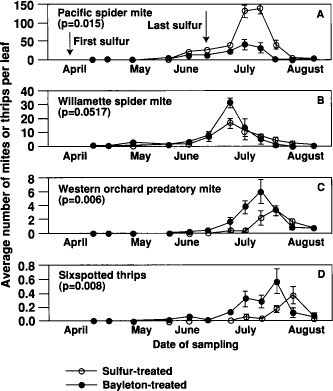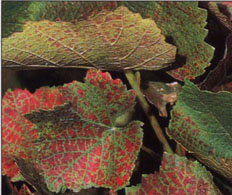All Issues
Sulfur can suppress mite predators in vineyards
Publication Information
California Agriculture 51(1):19-21. https://doi.org/10.3733/ca.v051n01p19
Published January 01, 1997
PDF | Citation | Permissions
Abstract
The Pacific spider mite and the Willamette spider mite are the most common mite pests on grapevines. A single-season study of a vineyard near Madera showed that regular sulfur applications for powdery mildew control can exacerbate spider mite problems in vineyards by suppressing populations of predatory thrips and predatory mites.
Full text
The Pacific spider mite, Tetranychus pacificus, and the Willamette spider mite, Eotetranychus willamettei, are the most common mite pests on grapevines in California. Although both mites can be found in vineyards, the Pacific spider mite is more prevalent in the hot interior valleys and causes economic damage at lower population densities than does the Willamette spider mite. The Willamette spider mite is also considered beneficial in some situations because it can be an important alternative prey for mite predators, and feeding by this mite on certain grape cultivars can make the vines less suitable for Pacific spider mite. Both Pacific spider mite and Willamette spider mite feed on grape leaves, causing reductions in leaf photosynthesis and stomatal conductance. Severe mite damage can reduce grape yield and quality, which may carry over to the following year under some conditions.
Several factors can affect mite densities and their pest status in vineyards. Factors that reduce vine vigor, such as water stress, generally increase the incidence and severity of mite outbreaks. Chemicals used for insect and disease control may increase mite problems by reducing the abundance of their predators.
Predatory mites and thrips are the most important predators of spider mites on grapevines. Although several species of predatory mites are present on wild grapes and in abandoned or minimally managed vineyards, chemicals used for insect and disease management severely restrict predatory mite diversity in commercial vineyards. The western orchard predatory mite, Metaseiulus (= Galendromus = Typhlodromus) occidentalis, is the primary phytoseiid predator found in commercial vineyards, presumably because this predatory mite has developed some tolerance to various chemicals used on grapes. The sixspotted thrips, Scolothrips sexmaculatus, is also an important predator that can provide control of high spider mite densities, but its abundance and activity are less predictable than those of the predatory mite.
Sulfur is widely used to control powdery mildew on grapes and several other crop plants in California. Observations by UC entomologists for many years have suggested that sulfur has a negative impact on tydeid mites and predatory mites, which are beneficial mites in vineyards. A study conducted by Drs. D. J. Calvert and C. B. Huffaker in 1974 showed that heavy sulfur use can be harmful to tydeid mites, which are beneficial as important alternate prey for predatory mites. (Tydeid mites can help in sustaining predatory mite populations in early spring and late fall when spider mites are low or absent.) In addition, former UC entomologist Dr. Marjorie Hoy (currently at the University of Florida) provided evidence in the early 1980s that some populations of the western orchard predatory mite had developed resistance to sulfur, but that there was a wide range of mortality among different populations. Populations with a long history of sulfur use appeared to have the greatest resistance to sulfur. However, sulfur impact on population levels of the western orchard predatory mite and the resulting impact on spider mite densities was not well understood. In addition, direct suppression of the sixspotted thrips and spider mites on grapevines had not been adequately demonstrated.
Western orchard predatory mite, Metaseiulus (=Galendromus) occidentalis. Adult female feeding on a Pacific spider mite egg.
Here we present a 1-year field study aimed at clarifying the relationship between history of sulfur use, impact of sulfur on predatory mites and thrips densities in the field, and the resulting impact on the abundance of Pacific spider mite and Willamette spider mite.
Figure 1A–D. Seasonal abundance of Pacific spider mite (A), Willamette spider mite (B), western orchard predatory mite (C), and sixspotted thrips (D) on sulfur-treated and triadimefon-treated vines. Data are mean number of mites or thrips per leaf. Bars represent standard errors. ANOVA.
Madera vineyard
We conducted this study in a 34-year-old ‘Thompson Seedless’ vineyard located near Madera. The vineyard had been under regular sulfur applications for powdery mildew control since planting, and had a long history of high spider-mite abundance. Two treatments were established in a randomized complete block design with four replicate blocks. Each block consisted of 200 vines (10 rows by 20 vines in a row). Half of each block was treated with sulfur and the other half was treated with triadimefon (Bayleton). Sulfur was applied at the rate of 10 to 12 lb/acre with an echo blower modified for dust applications. Sulfur applications began on April 12 and continued at 10-day intervals until June 24, for a total of seven applications. Triadimefon was applied by the grower with an orchard fan blower at approximately 18-day intervals at the rate of 3 oz/acre (50% dry flowable) material, beginning with the sulfur applications and ending on June 24 for a total of five applications. All plots also received two applications (early June and mid-July) of cryolite (Kryocide), which is a selective insecticide for the control of lepidopterous pests of grapes. No insecticides were applied to control variegated and western grape leafhoppers.
We collected leaves from the basal and middle third of shoots early in the season (April 24 to June 3, 1987) from the south and top zones of the single-trellis wire ‘Thompson Seedless’ canopy of each of three vines per plot to assess insect and mite numbers. During the remainder of the experiment (June 15 to Aug. 19), we collected leaves from the base, middle and terminal thirds of shoots located in the south, top and interior zones of each of three vines in each plot, for a total of 27 leaves per plot. Leaves were immediately chilled and were stored at 39°F (3°C) until counted. We counted all stages of spider mites, tydeid mites and predatory mites, and nymph and adult stages of sixspotted thrips. Thrips eggs were not counted. (Thrips eggs are inserted in the leaf tissue and could only be counted using light transmitted through the leaves).
Pest mites
Sulfur dust affected Pacific spider mite and Willamette spider mite differently under the conditions of our experiment. Overall Pacific spider mite density was significantly higher in sulfur plots than in triadimefon plots (fig. 1A), but these differences were greatest in July during peak Pacific spider mite abundance. This species was nearly absent from all plots during April and May, but increased much faster and peaked at 3.5-fold higher levels in sulfur plots than in triadimefon plots. Densities declined to near zero by mid-August.
Overall densities of Willamette spider mite were similar in both sulfur and triadimefon plots (fig. 1B). In May and early June, Willamette spider mite occurred at slightly higher levels in triadimefon plots, but reached (statistically nonsignificant) 1.8-fold higher levels in the triadimefon plots at peak densities on July 6 and declined faster in triadimefon plots than in sulfur plots.
Western orchard predatory mites
The impact of sulfur on the western orchard predatory mite was opposite that observed for the Pacific spider mite. The western orchard predatory mite reached 2-fold higher densities in triadimefon plots than in sulfur plots, despite the presence of greater prey abundance in sulfur plots (fig. 1C). Furthermore, predatory mites occurred earlier, increased faster and reached greater peak densities in triadimefon plots than in sulfur plots. Sulfur appeared to depress predatory mite populations up to 19 days after the cessation of sulfur treatments, despite the abundance of prey available.
Sixspotted thrips
Sulfur also had a negative impact on the sixspotted thrips. Densities of this predator followed similar patterns to predatory mite densities, reaching 2.5-fold greater abundance in triadimefon plots than in sulfur plots (fig. 1D). The sixspotted thrips occurred earlier, increased faster and peaked at greater densities in triadimefon plots than in sulfur plots. The negative effect of sulfur on sixspotted thrips was also apparent several weeks after the cessation of sulfur applications. However, sixspotted thrips densities were higher in late July in the sulfur plots than in the triadimefon plots, probably due to a delayed response to higher spider-mite densities in the sulfur plots.
Conclusions
Our results indicate that sulfur can affect the abundance of predatory mites and sixspotted thrips even in vineyards with a history of continuous sulfur use. Furthermore, population increases of both predators were delayed temporarily relative to what was observed in the triadimefon-treated plots. Reduced predator abundance, together with the delay in their population increase, could have resulted in increased Pacific spider mite abundance in the sulfur plots, although a direct effect of triadimefon on Pacific spider mite cannot be dismissed. This delay was not caused by lower prey levels in the sulfur plots, because both spider mites occurred at approximately similar levels in both sulfur and triadimefon plots early in the season. Tydeid mites, which could serve as alternate prey for predatory mites and are known to be negatively affected by sulfur, were very low in all plots.
Willamette spider mites damage the grape leaves by feeding on them. Sulfur applied to control powdery mildew on grapevines can suppress the predators that keep the Willamette spider mite in check.
Our field study documented that sulfur can suppress sixspotted thrips populations and can delay their increase. This predator has been considered less important than predatory mites because it typically controls spider mite infestations only after they have reached relatively high densities, such as we observed in the sulfur plots. It is possible that the late appearance of sixspotted thrips in vineyards has been somewhat related to sulfur use. Further investigation of sulfur's impact on sixspotted thrips seems warranted.
Sulfur may also have direct negative effects on spider mites. In our study, Willamette spider mite densities were slightly higher early in the season and peaked at greater levels in triadimefon plots than in sulfur plots, indicating a possible direct effect of sulfur on this species. This relationship was not apparent in the case of Pacific spider mite, possibly indicating some tolerance to sulfur by Pacific spider mite in this vineyard. Conclusive evidence supporting these observations requires predator exclusion from both treatments and sulfur bio-assay against known susceptible populations.
In this study, we determined the impact of sulfur applications on spider mites and their predators during a single season in a vineyard that had a chronic problem with spider mites. It is conceivable that the results may have been affected by weather conditions that were different from those observed in 1987.
Weather conditions during the 1987 season were favorable for spider mite outbreaks. Late spring and summer temperatures in 1987 were characteristically hot and dry. It is possible that the relative difference in spider-mite densities between sulfur and triadimefon treatments could have been lower if late spring and summer temperatures had been much cooler than observed during 1987. In addition, the impact of sulfur on spider-mite densities in vineyards depends on vine-related conditions that can affect the growth rate of spider-mite populations. Our field observations indicate that exclusive reliance on sulfur for powdery mildew control is more likely to result in higher spider-mite populations on stressed and weak vines than on vigorous vines.
Despite its negative impact on predators, sulfur remains necessary for powdery mildew management in vineyards. Alternating other effective fungicides with sulfur could allow a greater abundance of predatory mites and sixspotted thrips to survive in vineyards to help control spider-mite populations. Research by UC plant pathologists indicates that this approach would actually improve the efficacy of these chemicals and reduce the development of resistance in the powdery mildew fungus.



